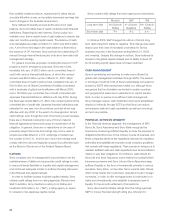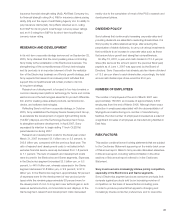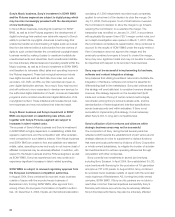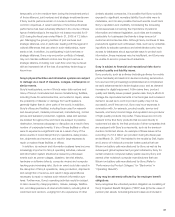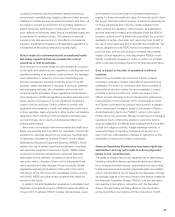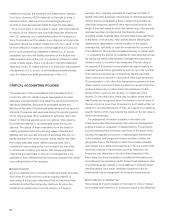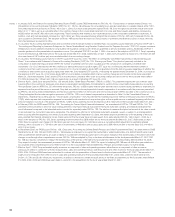Sony 2007 Annual Report Download - page 91
Download and view the complete annual report
Please find page 91 of the 2007 Sony annual report below. You can navigate through the pages in the report by either clicking on the pages listed below, or by using the keyword search tool below to find specific information within the annual report.88
pension expenses in a systematic manner over employees’
average remaining service periods in a manner consistent with
FAS No. 87, “Employers’ Accounting for Pensions,” FAS No. 158,
“Employers’ Accounting for Defined Benefit Pension and Other
Postretirement Plans” and the related amendments to those
standards. Any decrease of the pension asset value due to low
returns from investments or increases in the PBO due to a lower
discount rate, increases in rates of compensation and certain
other actuarial assumptions would increase the unfunded pension
obligations, and could, subject to the provisions of FAS No. 87,
result in an increase in pension expenses recorded as cost of
sales or as a selling, general and administrative expense. Refer to
Note 14 of Notes to Consolidated Financial Statements for more
information regarding Sony’s pension and severance plans. Also
refer to “Critical Accounting Policies,” below.
Most pension assets and liabilities recognized on Sony’s
consolidated balance sheets relate to Japanese plans, which are
subject to the Japanese Defined Benefit Corporate Pension Plan
Act pursuant to which Sony is required to meet certain financial
criteria including periodic actuarial revaluation and annual settle-
ment of gain or loss of the plan. In the eventuality that the
actuarial reserve required by law exceeds the fair value of pension
assets, Sony may be required to make an additional contribution
to the plan, which would reduce consolidated cash flow.
Changes in Sony’s tax rates or exposure to additional
tax liabilities could adversely affect its earnings and
financial condition.
Sony is subject to income taxes in Japan and numerous other
jurisdictions. Significant judgment is required in determining its
worldwide provision for income taxes. In the ordinary course of
our business, there are many transactions, including intercom-
pany charges, and calculations where the ultimate tax determi-
nation is uncertain. Also, Sony’s future effective tax rates could
be unfavorably affected by changes in the mix of earnings in
countries with differing statutory rates.
Further, Sony is subject to continuous examination of its
income tax returns by tax authorities. As a result, Sony regularly
assesses the likelihood of adverse outcomes resulting from
these examinations to determine the adequacy of its provision
for income taxes. However, there can be no assurance that the
outcomes of these examinations will not have an adverse effect
on Sony’s operating results and financial condition.
In addition, if Sony is unable to generate sufficient future
taxable income in certain jurisdictions, or if there is a significant
change in the actual effective tax rates or the time period within
which the underlying temporary differences become taxable or
deductible, Sony could be required to increase its valuation
allowances against its deferred tax assets resulting in an
increase in its effective tax rate and an adverse impact on
future operating results.
Sony’s business could suffer as a result of adverse outcomes
of current or future litigation and regulatory actions.
Sony faces the risk of litigation and regulatory proceedings in
connection with its operations. Lawsuits, including regulatory
actions, may seek recovery of very large, indeterminate amounts
or limit Sony’s operations, and the possibility that they may arise
and their magnitude may remain unknown for substantial periods
of time. A substantial legal liability or adverse regulatory outcome
could have a material adverse effect on Sony’s business, results
of operations, financial condition, and reputation.
Sony may be accused of infringing others’ intellectual
property rights and be liable for significant damages.
Sony’s products incorporate a wide variety of technologies.
Claims have been and could be asserted against Sony that
such technology infringes the intellectual property owned by
others. Such claims might require us to enter into settlement or
license agreements, to pay significant damage awards, and/or
to face a temporary or permanent injunction prohibiting Sony
from marketing or selling certain of its products, which could
have a material adverse effect on Sony’s business, results of
operations, financial condition, and reputation.
Sony is dependent upon certain intellectual property
rights of others, and Sony may not be able to continue to
obtain necessary licenses to employ technology covered by
such rights.
Many of Sony’s products are designed under the license of
patents and other intellectual property rights from third parties
who have developed technologies that are protected by such
rights. Based upon past experience and industry practice, Sony
believes that it will be able to obtain or renew licenses relating to
various intellectual properties useful in its business that it needs
in the future; however, such licenses may not be available at all
or on acceptable terms, and Sony may need to redesign or
discontinue marketing or selling such products as a result.
Increased reliance on external suppliers may increase
financial, reputational and other risks to Sony.
With the increasing necessity of pursuing quick business
development and high operating efficiency with limited manage-
rial resources, Sony increasingly procures from third-party
suppliers components (including LCD panels for televisions), and
technologies (such as operating systems for PCs). In addition, it




